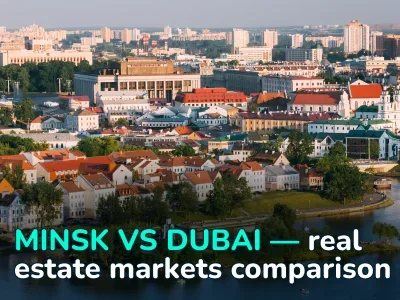
Another major real estate developer has gone bankrupt in Finland. We talked to an expert about the crisis in the construction industry in the Baltic States
Several subsidiaries of Finnish real estate developer Lehto Group, one of the biggest players in the market, have declared bankruptcy. This was the biggest collapse in the Finnish construction sector in recent times. We asked the expert what the reason was for such a crisis, not only in the Finnish market but also in the European market of new buildings in general.
A thesis of what happened:
- On Feb. 6, 2024, Lehto Asunnot, Lehto Tilat, and Lehto Korjausrakentaminen, covering the entire construction business of Lehto Group, filed for bankruptcy. Their activities formed the lion's share of the group's turnover.
- Lehto Group's turnover amounted to EUR 345 million in 2022 and EUR 154.5 million in the first 9 months of 2023. The company also reported an operating loss of EUR 23.4 million.
- In 2018, Lehto had a turnover of more than €720 million but then began to decline.
- Following the bankruptcy news, trading in the company's shares on the Nasdaq Helsinki exchange was suspended.
- One of Lehto's subsidiaries has two unfinished residential complexes in Oulu and Helsinki. Their fate is still unclear.
As a reminder, 2023 saw the highest level of bankruptcies in Finland in the last 25 years, with many bankrupt companies coming from the construction sector.
For example, on Aug. 28, 2023, Jukkatalo, which had existed for over 50 years and was the second-largest real estate developer in Finland, also declared bankruptcy. This came as a shock to many, as the company was known for a solid order book.
However, bankruptcy was inevitable due to unprofitable projects. The company could not continue to deliver housing at prices that would make it profitable. Losses of 4.6 million euros on revenues of 95 million euros in 2022 led to this crisis.
According to Helsingin Sanomat, in the first six months of 2023, bankruptcy proceedings were initiated against about 270 construction companies. By the end of August, the list had grown to almost 390 companies.
Due to the downturn in Finnish construction, workers from Estonia have started to return home, but the situation there is not easy either. Estonian construction companies are also leading in the number of bankruptcies.
The bankruptcy of Lehto Group is yet another example of the deep crisis in the construction industry in Finland and neighboring countries.
Roman Golubev, editor of the Latvian magazine “Kvadratniy Metr” and the portal varianti.lv, shared his expert opinion with us:
 — I am an expert primarily in the real estate market in Latvia, but I try to follow what is happening in our neighbors. I can say that the main trends and factors affecting the industry are quite similar.
— I am an expert primarily in the real estate market in Latvia, but I try to follow what is happening in our neighbors. I can say that the main trends and factors affecting the industry are quite similar.
The main thing we are now witnessing in the Baltic States and Scandinavia is a sharply increased cost of money and decreased demand. The rise in the cost of money was primarily because Europe started to fight against the rapidly increasing inflation in 2022, which at one point reached 20% in the Baltic States and about 10% in Scandinavia.
And they started to fight with one tool—raising interbank lending rates. This step hit everyone hard, as borrowed funds often finance business development, and buyers also actively use loans. Let's not forget that in 2022, the cost of construction in our region has increased significantly, as the usual logistics chains have been interrupted due to the geopolitical situation.
What happened was that the construction business in Finland (and, as far as I know, in Sweden as well) developed actively; companies built a lot, but the demand from buyers decreased significantly. After all, the cost of new apartments has risen, and people have started to look more carefully at how much they have to pay for their mortgage each month. Due to the increase in Euribor interest rates, these payments have increased significantly.
Here are some examples. If in Latvia, a person who took a 20-year loan for 80,000 euros until 2022 paid monthly on it about 450 euros, now pays more than 600 euros—an increase of 25%. And his financial situation has not changed much. In Finland, people could pay, for example, 1500–2000 euros a month on a mortgage, and when this payment increased, say, by 700–1000 euros, it, of course, hit the pocket because the income of the population did not grow as rapidly.
I would like to note that in Finland, real estate prices are very high, by our Latvian standards, so the trend of bankruptcies is more pronounced there. For example, in the center of Helsinki, the price per square meter is about 2.5-3 times higher than in Riga: if in our country a square meter of new housing costs 2,000-3,000 euros, in Finland it is 6000–9000 euros, or even more expensive.
Therefore, people are assessing whether they can afford a mortgage. And many realize that they cannot—it is too expensive. Many potential buyers in Finland, Estonia, and Sweden take a wait-and-see attitude, waiting for the Euribor rates (these rates are based on the average interest rates at which European banks lend to each other). For reference: Euribor rates in the EU zone have been negative for more than 8 years, and now they are just below 4% (there were periods when they even exceeded this value).
— But if buyers can wait, developers cannot. They have already built the objects, but there are no sales, and they have financial obligations. This is what leads to forced bankruptcy. I know that in Sweden, the situation in some regions is as follows: even if the developer agrees to give a 15-20% discount on his real estate, it still does not guarantee him a deal.
With such selective demand, construction companies find themselves in a difficult position, unable to fulfill their obligations to banks. And it should be understood that in the EU construction business, there is, in principle, low liquidity: 10% is considered an achievement. Many people were happy with 5%. And when expenses grow faster than revenues, real estate developers start working in the negative.
Regarding Latvia, I would like to note that we did not have such a rapid rise in real estate prices, so the situation in the segment of new housing is somewhat better. The fact is that in Latvia during the crisis of 2007–2009, prices dropped significantly and then did not grow so rapidly. Thanks to this, the situation in our country looks a little better than in neighboring countries. Now they say that the Latvian market is more stable and healthy compared to Estonia and Lithuania, where prices are 20-30% higher than in our country.
Therefore, to summarize, I repeat that the most painful impact of the growth of interest rates was on countries with higher real estate prices.
Author
I am responsible for editorial work. I write expert interviews and guides.























